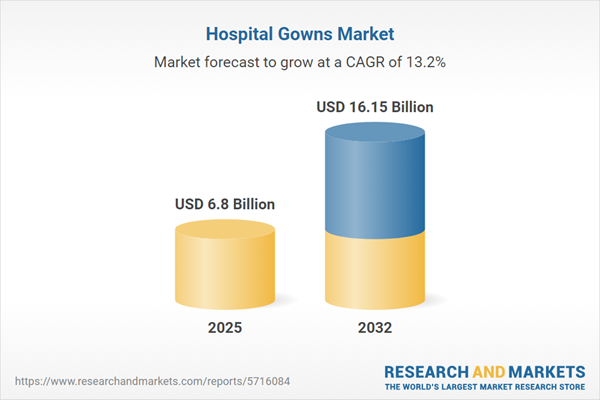Speak directly to the analyst to clarify any post sales queries you may have.
The hospital gowns market is evolving rapidly as healthcare organizations navigate new regulations, sustainability demands, and emerging supply chain complexities. Senior decision-makers are prioritizing procurement strategies that balance uninterrupted operations with compliance and environmental goals.
Market Snapshot: Growth Drivers and Outlook in the Hospital Gowns Market
The global hospital gowns market is achieving significant expansion, with market value projected to move from USD 5.99 billion in 2024 to USD 6.80 billion in 2025, reflecting a compound annual growth rate of 13.19%. By 2032, forecasts place market value at USD 16.15 billion, highlighting sustained demand propelled by advancing textile performance standards and ongoing innovation in clinical apparel. The landscape is influenced by growth in the number of healthcare providers, increased regulatory harmonization across borders, and a stronger integration of safety protocols within sourcing processes. As a result, procurement priorities are shifting toward sourcing diversification and increased attention to environmental and workplace safety throughout the value chain.
Scope & Segmentation: Strategic Levers in the Hospital Gowns Market
- Product Types: Closed back gowns ensure patient privacy and enhance procedural security, while open back gowns address flexible care requirements in varied clinical settings.
- Fabric Types: Options include cotton-polyester blends, pure cotton, polypropylene, and polyester, each bringing unique degrees of durability, breathability, and infection resistance to match distinct patient care protocols.
- End User Environments: Hospitals, ambulatory centers, outpatient clinics, and private practices maintain individualized purchasing strategies tailored to their operational pace and procedural needs.
- Distribution Channels: Procurement options span direct sourcing, partnerships with wholesale suppliers, retail arrangements, and utilization of digital sourcing platforms for streamlined, scalable inventory management.
- Regional Coverage: The market spans the Americas, Europe, Middle East & Africa, and Asia-Pacific, each region characterized by its own regulatory climate, compliance demands, and supply chain responsiveness.
- Key Players: Organizations such as Medline Industries LP, Cardinal Health Inc., Owens & Minor Inc., Kimberly-Clark Corporation, Mölnlycke Health Care AB, Paul Hartmann AG, Ansell Limited, Sioen Industries NV, TECNIMED S.p.A., and Alpha Pro Tech Ltd. are noted for their commitment to innovation, regulatory leadership, and environmental responsibility in medical apparel sourcing.
Key Takeaways for Senior Decision-Makers
- Optimized procurement strategies for hospital gowns directly influence infection control measures and support stringent compliance in clinical environments.
- Incorporation of advanced textile technologies such as antimicrobial treatments and modular gown designs positions organizations to improve patient outcomes and strengthen operational readiness.
- Aligning sourcing with sustainability initiatives by prioritizing recyclable or low-impact materials enables organizations to proactively address regulatory pressures and meet environmental benchmarks.
- Developing robust relationships with diverse supplier pools—especially across regional networks—reinforces supply chain durability against market disruptions and evolving regulatory expectations.
- Deploying digital procurement tools and automated supply chain management solutions supports efficient adaptation to new compliance mandates in hospital gown sourcing.
- Engagement with local vendors enhances the ability to quickly respond to policy shifts and changes in clinical or procurement processes.
Tariff Impact: Strategic Sourcing and Resilience
Current tariffs on imported medical textiles in the United States are prompting organizations to adjust sourcing strategies for hospital gowns. Senior procurement leaders are exploring nearshoring, domestic supplier engagement, and broader supplier diversification to mitigate price volatility and maintain reliable supply channels. The focus includes leveraging duty-exempt pathways where possible, negotiating flexible procurement contracts, and conducting detailed vendor evaluations to reduce risk and ensure consistent access to critical clinical apparel across healthcare entities.
Methodology & Data Sources
The findings draw on in-depth interviews with procurement executives, textile specialists, and distribution partners. These primary insights are complemented by an analysis of healthcare standards, sector regulations, and literature focused on optimizing hospital gown sourcing and procurement strategies.
Why This Report Matters
- Enables benchmarking of procurement, resilience, and sustainability best practices within the hospital gowns sector for senior leadership.
- Prepares organizations to modernize sourcing processes and adopt relevant technology solutions in response to changing clinical and regulatory demands.
- Provides actionable support for managing risks tied to shifts in protocols, active regulation, and unexpected supply chain disturbances.
Conclusion
Strategic, informed procurement approaches are essential for organizations managing complex regulatory and operational pressures in the hospital gowns market. This report offers vital guidance for secure, adaptable sourcing in today's healthcare landscape.
Additional Product Information:
- Purchase of this report includes 1 year online access with quarterly updates.
- This report can be updated on request. Please contact our Customer Experience team using the Ask a Question widget on our website.
Table of Contents
3. Executive Summary
4. Market Overview
7. Cumulative Impact of Artificial Intelligence 2025
Companies Mentioned
The companies profiled in this Hospital Gowns market report include:- Medline Industries, LP
- Cardinal Health, Inc.
- Owens & Minor, Inc.
- Kimberly-Clark Corporation
- Mölnlycke Health Care AB
- Paul Hartmann AG
- Ansell Limited
- Sioen Industries NV
- TECNIMED S.p.A.
- Alpha Pro Tech, Ltd
Table Information
| Report Attribute | Details |
|---|---|
| No. of Pages | 185 |
| Published | October 2025 |
| Forecast Period | 2025 - 2032 |
| Estimated Market Value ( USD | $ 6.8 Billion |
| Forecasted Market Value ( USD | $ 16.15 Billion |
| Compound Annual Growth Rate | 13.1% |
| Regions Covered | Global |
| No. of Companies Mentioned | 11 |









